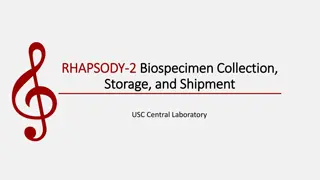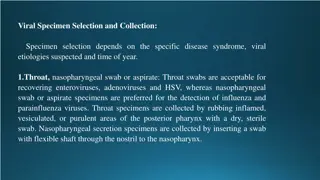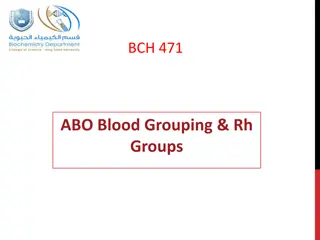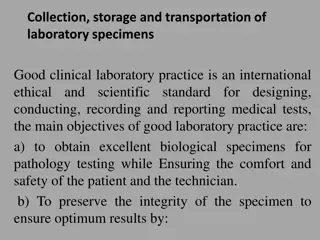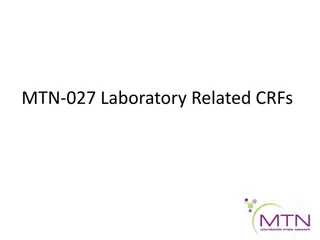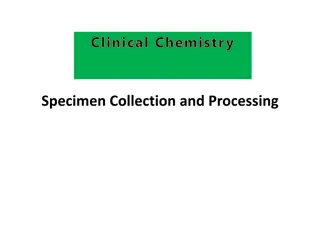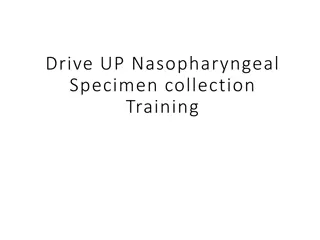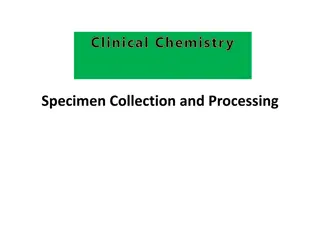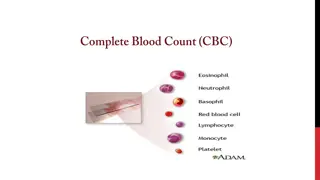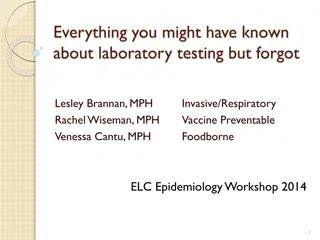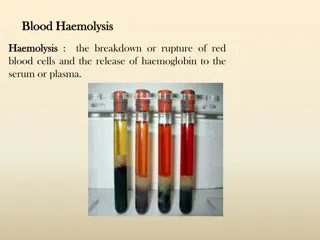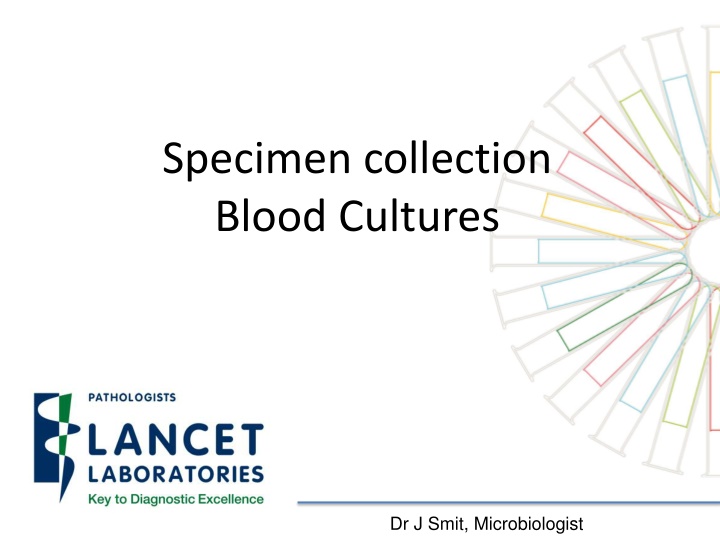
Optimizing Specimen Collection for Microbiologic Evaluation
Effective specimen collection is vital for accurate microbiologic evaluation. Learn about best practices, specimen handling techniques, and the importance of appropriate specimen submission to achieve optimal results in a timely manner.
Download Presentation

Please find below an Image/Link to download the presentation.
The content on the website is provided AS IS for your information and personal use only. It may not be sold, licensed, or shared on other websites without obtaining consent from the author. If you encounter any issues during the download, it is possible that the publisher has removed the file from their server.
You are allowed to download the files provided on this website for personal or commercial use, subject to the condition that they are used lawfully. All files are the property of their respective owners.
The content on the website is provided AS IS for your information and personal use only. It may not be sold, licensed, or shared on other websites without obtaining consent from the author.
E N D
Presentation Transcript
Specimen collection Blood Cultures Dr J Smit, Microbiologist
INTRODUCTION The goal of microbiologic evaluation is to provide accurate, clinically pertinent results in a timely manner. The quality of the specimens submitted to the microbiology laboratory is critical for optimal specimen evaluation. The general techniques of specimen collection and handling that have been established both to maximize the yield of organisms and isolate relevant pathogens from specimens obtained from different body sites will be reviewed here. The techniques of collecting specific specimens such as blood, sputum, and urine are discussed in more detail separately.
SPECIMEN COLLECTION Valid interpretation of the results of culture can be achieved only if the specimen obtained is appropriate for processing. As a result, care must be taken to collect only those specimens that may yield pathogens, rather than colonizing flora or contaminants. Make every effort to obtain specimens prior to the initiation of antimicrobial therapy. Wear gloves, gowns, masks, and/or goggles, when appropriate, when collecting specimens from sterile sites. Use strict aseptic technique. When obtaining specimens from normally sterile sites such as pleural or joint spaces, CSF, or the peritoneum, take care to minimize contamination by the normal colonizing flora of the skin or mucous membranes. Collect an adequate volume of specimen; send tissue or fluid whenever possible rather than submitting a specimen collected on a swab. If the specimen is collected in a syringe, remove the needle and replace it with a cap prior to transport.
Label all specimen containers with identifying information about the patient (name and hospital number or birth date) and the specimen source and date and time of collection. Complete all paper or electronic requisitions completely and precisely, including requested details on patient history, antimicrobial therapy, and specimen source, so that the laboratory can best determine the appropriate method for processing the specimen. Notify the laboratory in advance if special tests are requested or if unusual pathogens, including potential agents of bioterrorism, are suspected. Place warning labels on specimens from patients suspected of having highly contagious diseases and notify the laboratory supervisor. Coordinate the processing of specimens which are being submitted for both microbiologic and pathologic evaluations. It is often better to send a single specimen to the laboratory, and to have it divided there by an experienced pathologist, rather than submitting separate specimens. If a single sample is submitted, it must not be placed in the preservatives routinely used for pathology specimens (eg, formalin) until a portion is separated for culture. If there is any question about the optimal sample to collect, call the microbiology laboratory before obtaining specimens.
Bloodculture Introduction Bloodstream infections continue to be a major cause of morbidity and mortality despite advances in antimicrobial therapy and supportive care. Early diagnosis and appropriate treatment of bloodstream infections are important clinical concerns. Types of Bloodstream Infection In general, bloodstream infections have been classified as transient, intermittent, and continuous. Transient bloodstream infection usually follows mechanical or surgical manipulation of infected tissue. It might also occur during routine daily activities, such as tooth brushing or bowel movements. Intermittent bacteremia is typically seen with undrained abscesses or in association with localized infections such as pneumonia, urinary tract infection and central nervous system infection. Continuous bacteremia is observed with intravascular infections such as infective endocarditis, septic thrombophlebitis, or a mycotic aneurysm.
Indications for Blood Cultures Indications for blood cultures are varied and not standardized. Patients admitted to the hospital with suspected or proven infection at any site usually have blood cultures taken as part of their initial work-up. Fever, a frequent sign of bloodstream infection, is the most common reason and indication for culturing blood. However, fever may not be present in all patients with bloodstream infection. Elderly patients may be afebrile or present with low-grade fever during a bacteremic episode. Changing mental status or functional status may be the only sign of bloodstream infection in elderly patients or those with end- stage renal disease. Hypotension may be a manifestation of bloodstream invasion by microorganisms. If bloodstream infection is identified, it is usually not necessary to repeat blood cultures after treatment has been initiated, with the following exceptions. Patients with fungemia who have begun antifungal therapy should have repeat cultures done to document clearance of the organism. Similarly, patients with Staphylococcus aureus bacteremia with or without endocarditis should have repeat blood cultures performed after treatment is started, to document clearance of the bacteremia.
Skin Preparation Poor skin preparation prior to drawing blood cultures is the most common cause of culture contamination. The recommended approach is to first palpate the vessel to be punctured, then put on sterile gloves and then to apply 0.5% chlorhexidine in 70% isopropyl alcohol to the skin by scrubbing the skin vigorously for 60 seconds with soaked gauze and allow the skin to dry for 1 minute. DO NOT PALPATE AFTER CLEANING THE SKIN! Clean the seal of the bottle with 70% alcohol and squirt the blood in the bottle without changing needles. The vacuum in the bottle allow filling of the bottle with the correct volume of blood (8-10mls in adults). Each set of blood cultures should be obtained from a different site using the same technique. Timing and Intervals of Blood Cultures The optimal time to obtain blood cultures is when the magnitude of the microorganisms is greatest in the bloodstream. It was found in experimental infections that the largest number of microorganisms in the blood occurred 12 hours before onset of fever or chills. Previously, an interval of 30 to 60 minutes between blood culture sets was recommended for optimal results. However it was found there is no significant difference in the yield of blood culture sets drawn simultaneously and those drawn with an interval period between sets. An exception to this may be when endocarditis is suspected; in this situation, drawing blood cultures over several hours can document continuous bloodstream infection typical of endocarditis.
Sites for Obtaining Blood Cultures Blood obtained by venipuncture is the method most commonly used for obtaining samples for culture. In the intensive care setting, blood for culture is frequently obtained from intravascular catheters (venous or arterial). However, there is concern about an increased risk for contamination of blood cultures obtained via intravascular catheters. If blood cultures are obtained from intravascular catheters, they should be labeled as such to take this into consideration when assessing positive cultures. Number of Blood Culture Sets Eighty percent of bacteremic episodes are detected by the first set of blood cultures, while 89% and 99% of episodes are identified by the first two or three sets, respectively. The following recommendations concerning the number of blood cultures to draw: (i) one blood culture set is never sufficient for identifying or excluding bacteremia; (ii) two blood culture sets are necessary and sufficient to exclude or identify bacteremia when the organism is not a common contaminant and the probability of bacteremia is low (5%) or moderate (20%), such as with pneumonia, intra-abdominal infection, or urinary tract infection; (iii) three to four blood culture sets (high sensitivity) should be obtained to exclude bacteremia when the probability of bacteremia is high or continuous bacteremia (e.g., endovascular infection) is a consideration; and the suspected pathogen is a common contaminant (e.g., prosthetic valve endocarditis caused by a coagulase-negative staphylococcus) or the patient with suspected endocarditis has recently received antibiotic therapy.
Volume of Blood for Culture During a bacteremic episode in adults, the number of microorganisms in the bloodstream is usually low (~110 cfu/ml). Therefore, the volume of blood obtained for culture is relevant to the detection of bloodstream infection. In pediatric patients, a lesser volume of blood (1-6ml) is required for culture because the magnitude of bacteremia is greater in children and neonates. Anaerobic Blood Cultures It has been a standard of practice that a set of blood cultures consists of one aerobic bottle and an anaerobic bottle. However, because the likelihood of detecting fungi or obligate aerobic organisms is low when blood is incubated anaerobically, anaerobic blood cultures may decrease the overall sensitivity of blood cultures. Several studies have found a significant decrease in the incidence of anaerobic bloodstream infections during the last two decades (Only 0.2% of all the positive blood cultures during the last year at Lancet Johannesburg were anaerobes). At the same time, there has been an increase in the incidence of candidemia.
There may be circumstances in which blood should be cultured anaerobically, but these should be well defined. Gastrointestinal tract surgery or traumatic puncture of the Bowel Genital tract surgery or traumatic puncture of the genital tract Introduction of soil into wound with presence of a large quantity of gas Human or animal bite wounds Aspiration pneumonia Blood Culture Contamination Of all positive blood cultures, approximately half represent contamination. These high rates of contamination create confusion in regard to the need for antimicrobial therapy. Some useful guidelines for differentiating between contaminated and true positive blood cultures: both the number of positive blood cultures and the identification of the organism are helpful in differentiating true positive from contaminated blood cultures. Isolation of organisms such as group A streptococci, pneumococci, Escherichia coli, and Candida species almost always indicated true bacteremia. In contrast, organisms such as diphtheroids and Bacillus species were found only as contaminants.


